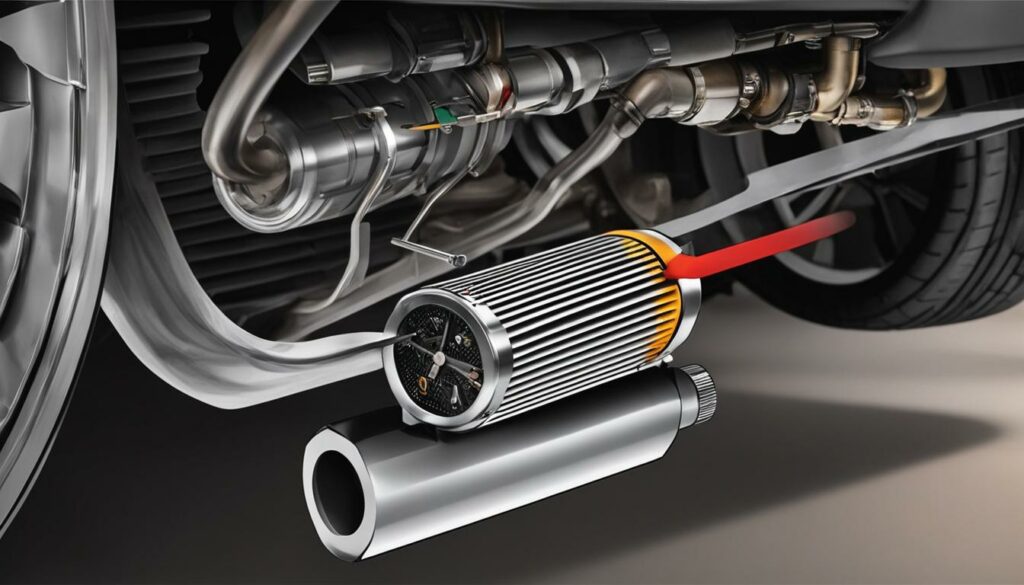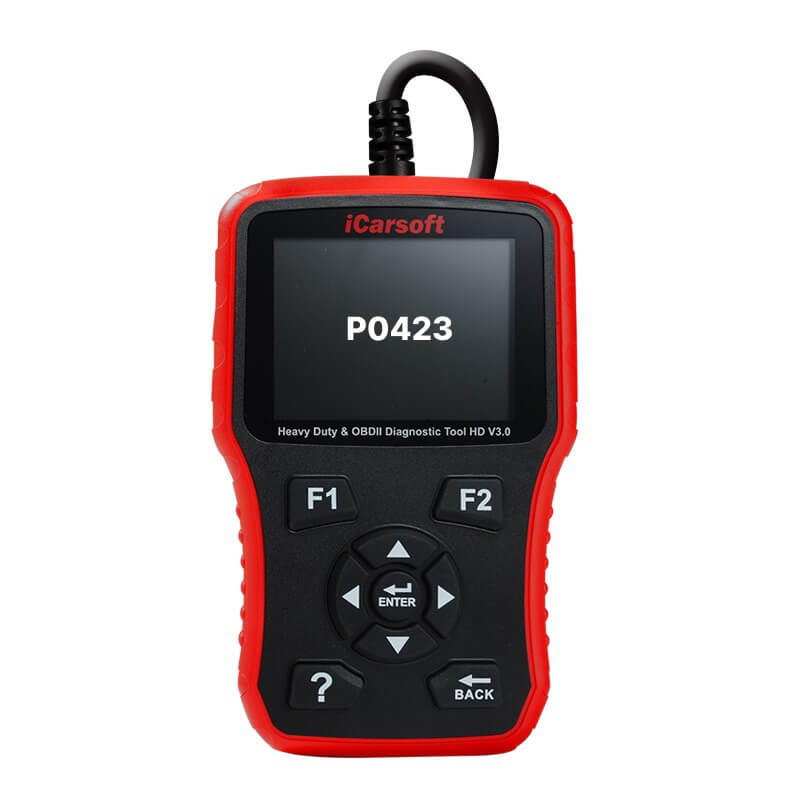P0423 – Heated Catalyst Efficiency Below Threshold
POSTED IN pcodes
Welcome to our comprehensive guide on the P0423 code, which indicates a problem with the heated catalyst efficiency in your vehicle’s engine bank 1. This code, often referred to as “Heated Catalyst Efficiency Below Threshold,” is an important indicator of potential issues with your catalytic converter, air injection system, or O2 sensor.
When the heated catalyst efficiency falls below the threshold programmed in the engine control module (ECM), it can lead to various symptoms and potential damage. It is crucial to understand the causes, diagnosis, and repair process for the P0423 code in order to address the issue effectively and prevent further complications.
Key Takeaways:
- The P0423 code indicates a problem with the heated catalyst efficiency in bank 1 of your vehicle’s engine.
- Possible causes of the code include a faulty catalytic converter, issues with the air injection system, or a malfunctioning O2 sensor.
- Common symptoms of the P0423 code include an illuminated Check Engine Light and potential driveability issues.
- Diagnostic steps involve scanning for codes, inspecting the catalytic converter and O2 sensor, and checking the air injection system.
- It is important to accurately diagnose and address the P0423 code to prevent further damage and ensure compliance with emission standards.
Understanding the P0423 Code
The P0423 code is a generic OBD-II code that alerts the ECM to a problem with the heated catalyst efficiency in bank 1. This code indicates that the performance of the catalyst is below the threshold set by the engine control module.
The severity of the P0423 code can vary depending on the extent of the issue. In some cases, the problem may be minor and have a minimal impact on engine performance. However, in more severe cases, the decreased efficiency of the catalyst can lead to drivability issues and potential damage to the engine.
If your vehicle has triggered the P0423 code, you may notice symptoms such as an illuminated Check Engine Light. This warning light indicates that there is a problem with the emissions system, specifically the heated catalyst in bank 1. It is important to address this code promptly to prevent further damage to the engine and to ensure that your vehicle meets emission standards.
Buy tested tuning file for Adblue / EGR / DPF / Adblue off now!
It is important to note that the P0423 code specifically relates to the heated catalyst in bank 1. If you have a vehicle with multiple banks of cylinders, such as a V6 or V8 engine, there may be separate codes for each bank. Therefore, it is essential to accurately diagnose and repair the issue in the appropriate bank.
Common Causes of the P0423 Code
When the P0423 code is triggered in your vehicle, it indicates that there is an issue with the heated catalyst efficiency in bank 1. The catalyst efficiency refers to the ability of the catalytic converter to convert harmful emissions into less harmful substances. Various factors can contribute to the occurrence of the P0423 code, including:
- Faulty Catalytic Converter: A faulty catalytic converter can lead to decreased catalyst efficiency. Over time, the catalytic converter may lose its effectiveness or even break apart, resulting in a significant decrease in its ability to convert harmful emissions into less harmful substances.
- Air Injection System Problems: Issues with the air injection system can also cause the P0423 code. The air injection system is responsible for injecting air into the catalytic converter to aid in the conversion process. If the system is not functioning correctly, it may pump either too much or too little air into the catalytic converter, affecting its efficiency.
- Malfunctioning O2 Sensor: The P0423 code can be triggered when the O2 sensor post-catalyst on bank 1 is not functioning properly. The O2 sensor monitors the oxygen levels in the exhaust gases before and after they pass through the catalytic converter. If the sensor is not providing accurate readings, it can lead to incorrect adjustments in the fuel-air mixture, impacting the catalyst’s efficiency.
Identifying the specific cause of the P0423 code requires a thorough diagnosis by a professional mechanic, who can use specialized tools and techniques to pinpoint the exact source of the issue. This will ensure that the appropriate repairs are made to restore the catalyst’s efficiency and resolve the P0423 code.
In some cases, replacing the catalytic converter or repairing the air injection system or O2 sensor may be necessary. However, it is essential to accurately diagnose the problem before proceeding with any repairs to avoid unnecessary expenses and ensure an effective solution.

Symptoms of the P0423 Code
When the P0423 code is triggered, the Check Engine Light will be illuminated, indicating a potential issue with the vehicle. This warning light serves as a valuable tool for alerting drivers to underlying problems within the engine. The P0423 code is specifically related to the heated catalyst efficiency in bank 1, which refers to the vehicle’s exhaust system.
Although the symptoms of the P0423 code can vary depending on the specific circumstances, there are a few common signs to watch out for:
- Check Engine Light: The illuminated Check Engine Light is the primary symptom associated with the P0423 code. This warning light serves as an early indication that something is amiss with the heated catalyst efficiency.
- Drive Symptoms: In some cases, the engine may not exhibit any noticeable drive symptoms other than the illuminated Check Engine Light. It’s essential to address this code promptly to prevent further damage to the engine.
- Blocked Exhaust: If the catalytic converter is damaged and clogging the exhaust, symptoms of a blocked exhaust may occur. These can include a loss of power, misfiring, or decreased performance in the vehicle.
“The presence of the Check Engine Light shouldn’t be ignored, as it can represent a potential issue with the heated catalyst efficiency. It’s important to take prompt action to diagnose and repair the P0423 code to prevent further complications.”
Symptoms of the P0423 Code
| Symptom | Description |
|---|---|
| Check Engine Light | The illumination of the Check Engine Light is a common symptom associated with the P0423 code. |
| Drive Symptoms | In some cases, there may be no noticeable drive symptoms other than the illuminated Check Engine Light. |
| Blocked Exhaust | If the catalytic converter is damaged, a blocked exhaust may occur, leading to power loss and misfiring in the vehicle. |
It’s important to note that the symptoms of the P0423 code can also be indicative of other issues within the vehicle’s engine. Therefore, it is recommended to consult a professional mechanic for a thorough diagnosis and appropriate repair.
Diagnostic Process for the P0423 Code
To diagnose the P0423 code, a mechanic will typically perform the following steps:
- Scan for codes and document freeze frame data to verify the problem
- Clear the engine codes and retest the air injection system
- Check the catalytic converter and O2 sensor for damage
- Scan the O2 sensors to compare pre and post-catalyst readings
- Check the air injection pump for proper operation
- Compare pre and post-catalyst readings between bank 1 and bank 2
Common Mistakes in Diagnosing the P0423 Code
When diagnosing the P0423 code, it is crucial to avoid common mistakes that can lead to inaccurate diagnoses and unnecessary repairs. By understanding these pitfalls, you can approach the diagnostic process with confidence and effectively resolve the underlying issue causing the code.
Not Checking the Operation of the Air Injection Pump
A common mistake is neglecting to check the operation of the air injection pump before replacing the catalytic converter or post O2 sensor. The air injection pump plays a crucial role in delivering the correct amount of air to the catalytic converter. If the pump is not functioning properly, it can mimic the symptoms of a faulty catalytic converter or O2 sensor, leading to unnecessary repairs.
Not Checking the Exhaust System for Leaks
Another common mistake is failing to check the exhaust system for leaks before replacing the O2 sensor. A leak in the exhaust system can cause false readings and trigger the P0423 code. By inspecting the exhaust system for leaks, you can identify and address the root cause of the issue without replacing components unnecessarily.
Thoroughly inspecting and testing all components related to the P0423 code, including the air injection pump and exhaust system, is essential for accurate diagnosis and effective repairs. By avoiding these common mistakes, you can save time, money, and unnecessary repairs.
Severity and Repairs for the P0423 Code
The severity of the P0423 code can vary depending on the specific circumstances. When this code appears, it indicates a problem with the catalyst in your vehicle’s engine bank 1. If left unresolved, it can lead to more severe issues such as a blocked exhaust system or damage to other engine components.
One immediate effect of the P0423 code is the illumination of the Check Engine Light on your dashboard. This serves as an important indicator that there is a problem that needs to be addressed. Furthermore, if not resolved, the code can cause your vehicle to fail emission testing. This is because the emission output levels may exceed the legal limits set by the authorities.
To rectify the P0423 code, repairs may include replacing the post O2 sensor for bank 1. The O2 (oxygen) sensor is responsible for monitoring the level of oxygen in the exhaust gases. A malfunctioning sensor can lead to inaccurate readings and trigger the P0423 code. Alternatively, the catalytic converter itself may need to be replaced. The catalytic converter plays a crucial role in reducing harmful emissions by converting them into less harmful substances. If the converter is faulty or damaged, it can result in reduced efficiency and trigger the P0423 code.
It is important to consult with a professional mechanic to accurately diagnose the cause of the P0423 code and determine the appropriate repair process. They will have the expertise and tools necessary to conduct a thorough inspection and make accurate repairs, ensuring your vehicle meets the necessary emission standards and operates efficiently.

| Severity | Effects | Repair Options |
|---|---|---|
| Minor | Illuminated Check Engine Light | Replace post O2 sensor for bank 1 |
| Severe | Blocked exhaust system, potential engine damage | Replace catalytic converter |
Conclusion
In conclusion, the P0423 code signifies an issue with the heated catalyst efficiency in bank 1 of your vehicle’s engine. This error can occur due to various causes, such as a malfunctioning catalytic converter, problems with the air injection system, or a faulty O2 sensor. To accurately diagnose the root cause of the code and determine the appropriate repair process, it is crucial to seek professional assistance from a qualified mechanic.
By consulting a professional, you can ensure an accurate diagnosis of the P0423 code and prevent unnecessary repairs or part replacements. A mechanic will thoroughly inspect the catalytic converter, air injection system, and O2 sensor to identify any faults or deficiencies. Once the specific cause has been identified, the mechanic can guide you through the appropriate repair process to restore the heated catalyst efficiency in bank 1.
If professional assistance is not readily available, an alternative solution for permanent removal of the P0423 code is uploading the Engine Control Unit (ECU) file to a portal. However, it is crucial to note that this method may not address the underlying issue and could lead to further complications. Therefore, it is always advisable to consult a professional for a comprehensive diagnosis and reliable repair of the P0423 code.
FAQ
What does the P0423 code mean?
The P0423 code indicates that the heated catalyst efficiency in bank 1 is below the threshold programmed in the engine control module (ECM).
What are the common causes of the P0423 code?
The common causes of the P0423 code include a faulty catalytic converter, issues with the air injection system, or a malfunctioning O2 sensor.
What are the symptoms of the P0423 code?
Symptoms of the P0423 code may include an illuminated Check Engine Light and potential driveability issues.
How is the P0423 code diagnosed?
To diagnose the P0423 code, a mechanic will typically perform steps such as scanning for codes, checking the catalytic converter and O2 sensor, and comparing pre and post-catalyst readings.
What are some common mistakes when diagnosing the P0423 code?
Common mistakes when diagnosing the P0423 code include not checking the operation of the air injection pump before replacing the catalytic converter or post O2 sensor, and not checking the exhaust system for leaks before replacing the O2 sensor.
How severe is the P0423 code and what repairs are needed?
The severity of the P0423 code can range from minor to severe, depending on the specific circumstances. Repairs may include replacing the post O2 sensor for bank 1 or replacing the catalytic converter.


